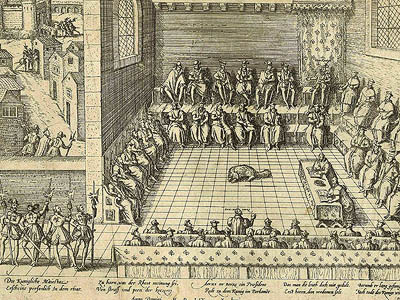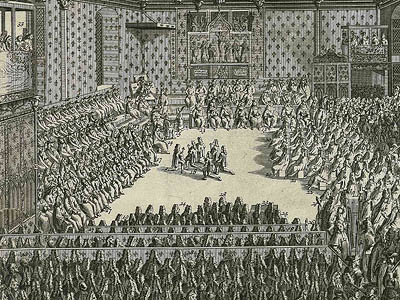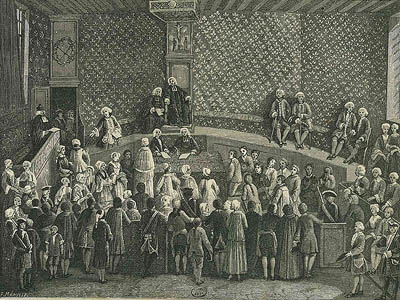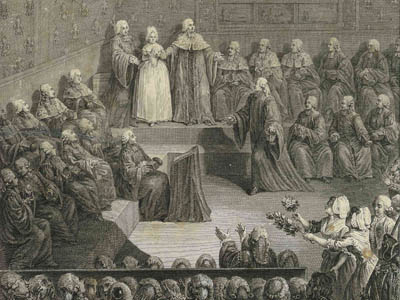In the past
Before the Revolution
People have been making visual representations of courtroom scenes for centuries, but from the 16th century onwards, thanks to engraving, the genre was more widely diffused.
Here, the examples show the wide variety of subjects this category of drawing can cover: an exceptional event, like the confrontation between a judge and Henri II; a solemn ceremony like the so-called ‘lit de justice’ or simply an ordinary hearing in the Tribunal du Châtelet.
At the end of the Ancien Régime, artists were often inspired by ‘causes célèbres’.
Image n°1 : A Protestant Judge Faces the King of France, 1559. German version of an engraving by Perrissin and Tortorel.

Ordre des avocats de Paris . 1570. Engraving, 20,5x27,2cm.
On June 10, 1559, Henri II attended a sitting of the Parliament in Paris, accompanied by members of his private council. As he sat beneath a canopy decorated with fleurs de lys, Anne Du Bourg addressed him directly, speaking in defence of the persecuted Protestants. Taken to the Bastille (on the left) he was condemned to death and executed..
© Ordre des avocats de Paris
Image n°2 : The "lit de justice" held by Louis XV, Feb. 22, 1723.

Ordre des avocats de Paris . XVIIIe siècle. Engraving, 31x20cm.
Strictly speaking, the ‘lit de justice’ was the throne where the king sat, beneath a canopy, when he presided a solemn session of Parliament in Paris. By extension, the term ‘lit de justice’ came to refer to the ceremony itself. It took place in the Law Courts in Paris, to celebrate the sovereign’s coming of age which was fixed at 13. In the caption, a detailed list of those in attendance..
© Ordre des avocats de Paris
Image n°3 : A trial at Châtelet during the reign of Louis XV.

Ordre des avocats de Paris . XIXe siècle. Engraving, 15x20cm.
Before the Revolution, the Law Courts at Châtelet in Paris was an important jurisdiction, with extensive police powers, in the widest sense of the term, placed under the direction of the Lieutenant général de police. Here, we see thieves and prostitutes being tried. In the 18th century, this representation existed only in painting. It was popularized in the form of an engraving one century later..
© Ordre des avocats de Paris
Image n°4 : The Parisian court saves an innocent woman, 1786. .

Ordre des avocats de Paris . XVIIIe siècle. Engraving, 36,8x25cm..
In 1781, Marie Salmon, servant to a bourgeois family in Caen, was wrongly accused of having poisoned the master of the house. She was condemned to be burnt alive by the judges in Caen in 1782. But serious procedural irregularities were revealed and the case, which impassioned public opinion, was sent before the parliaments of Rouen then Paris.When the Parisian court found the accused woman innocent, an enthusiastic crowd celebrated their decision..
© Ordre des avocats de Paris


